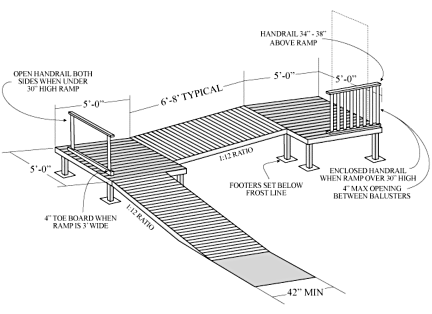You must have come across ramps that are too steep for a wheelchair. Most establishments try to get around the law by just installing any wheelchair ramp. They don’t even think for a bit if the ramp can really be used! This is the reason finding very steep ramps is not unusual in various parts of the world. Wheelchair Ramp Ratio is the measure that defines how steep a ramp should be.
In most part of the world, Wheelchair Ramp Ratio is 1:12. This means that for one inch of rise, the ramp should be 12 inches long. In other words, one foot length for one inch rise.
Let’s understand the Wheelchair Ramp Ratio with the help of an example. Suppose, you have a doorway that is two feet (24 inches) high from the ground level. So, you would need to install a ramp that is 12×24 = 288 inches or 24 feet long.

Wheelchair Ramp Ratio (WRR) in Various Countries
- United States: the Americans with Disabilities Act (ADA) requires a WRR to be 1:12
- United Kingdom: the Disability Discrimination Act 1995 and Equality Act 2010 also require the WRR to be 1:12
- Hong Kong: Barrier Free Access terms of Hong Kong dictate that the WRR should be 1:12
- Australia: the Australian Standards Council mandates 1:14 meters of Wheelchair Ram Ratio. This means that for every one meter rise there has to be 14 meters long ramp.
ALSO SEE: History of Wheelchairs!
Length and Width of Wheelchair Ramps
It’s not just the slope, but the length and width of a wheelchair ramp also matter. A too long ramp without rest platform may fatigue the wheelchair user. A narrow ramp poses the danger for the wheelchair to run over the edges.
Americans with Disabilities Act (ADA) in USA says that there must be a rest or turn platform after every 30 feet of ramp. This means that the ramp can be of any length but a single run of the ramp should not be longer than 30 feet. After every 30 feet or less there must be a rest or turn platform.
As per Australian Standards Council, the width of a wheelchair ramp has to be at least one meter.
Please feel free to ask any question on this subject. Also, we would be grateful if you could contribute more information relevant to this topic. Thank you for connecting with WeCapable!
Use the citation below to add this article to your bibliography
"Wheelchair Ramp Ratio: A Ramp Should Not be Too Steep." Wecapable.com. Web. July 27, 2024. <https://wecapable.com/wheelchair-ramp-ratio/>
Wecapable.com, "Wheelchair Ramp Ratio: A Ramp Should Not be Too Steep." Accessed July 27, 2024. https://wecapable.com/wheelchair-ramp-ratio/
"Wheelchair Ramp Ratio: A Ramp Should Not be Too Steep." (n.d.). Wecapable.com. Retrieved July 27, 2024 from https://wecapable.com/wheelchair-ramp-ratio/

Is there any Wheelchair Ramp Ratio (WRR) in India?
The difficult ramps are curb cutouts, especially the ones with metallic hobnails and those nowhere near the crosswalk buttons.
The ramps I find particularly useless are those with railings where the uprights holding the railing are so far apart they are no help to pull myself along. Two that come to mind: US Post Office, Rockville Centre, NY 11570 and Long Island Jewish Valley Stream Medical Center, VS, NY
11580. Very steep ramps.
And, for some reason that makes no sense, Nassau County, NY’s Able Ride paratransit drivers let the lift down at a curb cutout rather
than onto the flat of the side-walk. Thus the struggle to go down the often narrow ramp and then immediately try to get up the little ramp onto the lift. Most manual wheelchairs have too small front wheels for this. Able Ride wants getting on the lift backwards! Often the little flap ramp doesn’t even touch the ground fully.
Anger at this nonsense, distress to my spine which is already damaged enough I’m in a wheelchair, is then followed by more poor handling and further injury in the bus and then when getting out of it and into where I’m going.
Disability is no prize, but the things said and done by those who think they are “meaning well” often are the biggest handicap.
I have not been to India but know others who have. Popular tourist sites and major cities gave them very few problems. I assume major chain hotels have what they consider to be handicap accessible accommodations. For the most part I can say that properties by Hilton, Marriott, IHG, Hyatt and Wyndham, all of which I have visited have very little understanding of what constitutes handicap accessible. Just getting in an ADA-door-width doesn’t mean a thing if the rest of the place can’t be used comfortably, if at all. Sometimes the main entry has a difficult slope up to it.
Often there are bricks as a surface sometimes painted so shiny and slick.
At a Hyatt and a Hilton property, the electric eye did not see me at wheelchair height so I could not get out of the places.
And then, the entry areas are edged with the smokers usually given benches and ashtrays they don’t use. So, as you struggle up the entry ramp you get to inhale smoke.
Elizabeth, thank you for sharing your experiences! I completely agree with your views. In India too, a lot of places have ramps just for the sake of it. Many are too steep to be independently used by the wheelchair user. Making a ramp too far away from main entrance is also a huge problem. It is embarrassing to become separated from the group of people just because you have to use a ramp located very far.
I wish if you could write your experiences as an article on WeCapable! I would love to publish your views.